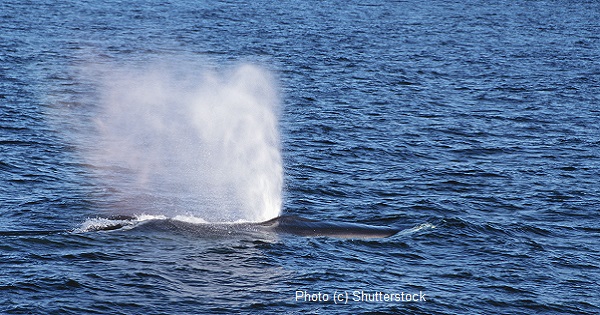|

Respectful Whale Watching
By Wendy Priesnitz
Anyone who has ever watched up close as a massive whale shepherds her youngster majestically through the deep waters of the Bay of Fundy feels changed forever. So it’s no wonder that whale watching is a growing ecotourism industry around the world. According to the Whale and Dolphin Conservation Society, whale watching now generates over $500 million a year worldwide, and is enjoyed by over six million people in 65 countries. By canoe on the Amazon, in an off-season whaling boat in Norway, or a luxury ship in Alaska, people are going everywhere in search of whales and dolphins.
Whale watching can be emotional, educational and an important part of local economies. It offers a unique opportunity for people to appreciate the magnificence of whales in their natural habitat and to help motivate people to protect these animals and their environment. Additionally, much of what scientists know about whales is a result of research conducted while they are aboard commercial whale watching vessels.
However, unregulated whale watching can also lead to problems, including threats to the animals’ health and well-being and negative impacts on fragile coastal environments. The ecotourism industry has discovered the importance of promoting "taking nothing but pictures, leaving nothing but footprints". Some whale watching companies, however, lag far behind the rest of the ecotourism industry because of explosive growth in new and unregulated markets, less obvious impacts on cetaceans and their habitat, an enthusiastic but often naive public, and the drive for profit above all else.
In British Columbia, the negative impact of too many whale watching boats is one of a number of factors that has caused the orca whale to be listed as threatened by the Canadian government. There are stories of people in Florida feeding French fries to wild dolphins and some tour operators in that state operate dolphin petting tours. With an increase in whale watching boats and pleasure craft, traffic jams around whales occur all too often. In mid-February, a 20-foot humpback whale leaped onto a whale watching boat near Hawaii and injured a tourist’s knee.
In addition to increasing numbers of whale watching vessels in many parts of the world, newer boats are capable of going much faster than in the past, with the increasing likelihood that whales will be hit by boats. Researchers from the Woods Hole Oceanographic Institution have found that if whales are feeding and/or socializing, they are less likely to react to an oncoming vessel and can be hit. Researchers at the New England Aquarium have shown that large vessels, which collide with whales at higher speeds, are more likely to kill them. The International Wildlife Coalition, the parent group of the Whale Adoption Project, has summarized scientific literature to demonstrate that the faster a vessel moves, the less likely the operator is to see a distant whale, and the less time they have to react once they do spot an animal.
In response to this problem, whale watch groups, government agencies and private advocacy groups have established codes of conduct for whale watching.
In Washington State’s San Juan Islands, the Whale Watching Operators Association Northwest acts as a self-policing group to make sure whale-watching vessel captains in the San Juan Islands comply with the federal Marine Mammal Protection Act and current whale-watching guidelines offered by The Whale Museum’s Soundwatch Boater Education Program. This program began its unique on-the-water work in 1993, handing out an informational flyer "Best Practices for Viewing Marine Wildlife" to boaters who are in the vicinity of whales.
Off the east coast in the Bay of Fundy, marine tour operators have created a Code of Ethics, which governs their actions. The purpose of this Code is to foster an environment of cooperation and trust among marine tour operators for the protection and safety of the whales and other marine life. The majority of tour operators adhere to these guidelines.
The Cetacean Society International (CSI) has entered into an unusual agreement with one of the major whale watch tour companies in Europe, Whale Watching Worldwide (WWW). The agreement is based on the premise that responsible and willing operators like WWW understand and accept responsibility for the cumulative impacts they may contribute to by taking tourists into sensitive areas.
These whale watching industry guidelines should also be followed by private boaters, including kayakers. Here are suggestions culled from a variety of guidelines:
Approaching an area of known whale activity should be done slowly and with extreme caution, stopping to survey the area. In addition, approach parallel to the whales and travel at the same speed as the slowest animals. Stay at least 100 metres away and don’t leapfrog into the path of the whales. Preferably, there should only be two vessels at a time viewing a group of whales.
Move away from whales demonstrating avoidance behavior such as turning away or increasing speed. Never herd or chase marine mammals or separate any groups or pairs, such as a mother and her calf. Avoid positioning vessels in a way that restricts or modifies a whale’s normal movements.
If approached by whales, maintain speed or slow down, but move away from the nearest whale, or stop the boat and watch until the whales move more than 100 metres away.
Approach whale watching with reasonable expectations. Those wonderful wildlife documentaries you watch on television took months to film; don’t expect that kind of experience on a half-day excursion. In many instances irresponsible demands from passengers on whale watching expeditions are partly responsible for situations where disturbance occurs.
Don’t be afraid to express your concerns to the boat captains if you witness actions on their part that seem to disturb whales. In a competitive business environment, they want their customers to have a good experience.
Wendy Priesnitz is the Editor of Natural Life Magazine and a journalist with over 40 years of experience. She has also authored 13 books.
|

